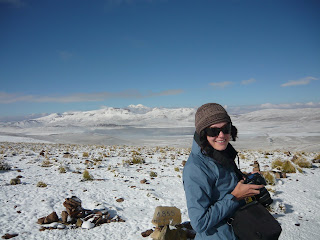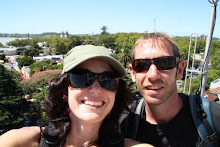



We returned on Saturday from the Bolivian highlands where we did a 4 day jeep tour through widely diverse landscapes including the Salt Flats. This was true 4WD country from beginning to end and we crossed rivers and mountains on very narrow and often barely distinguishable rocky roads. Luckily we had an excellent local driver and a great Bolivian guide Archie who spoke English and also cooked us delicious huge meals throughout the trip. There was also an Irish couple with us, and 6 was a good amount of people for 4 days in a vehicle together.
The region changes constantly and we experienced sun, snow, wind, hail and mountains of lofty heights of between 4000 and 5000+ metres. For the most part, we were not affected by altitude sickness, but you can definitely feel the shortness in breath and sometimes a headache for me. At such heights, it is really cold, expecially when you are getting up at 4.30am when it was around 0 degrees.
This corner of the world is largely volcanic but nothing has erupted for the past 1000 years. The landscape changes from hard rock mountains to gentle slopes with spiky shrubbery and cactus, with animals such as the vicunas and llamas which are everywhere and a industry for the local villages (yes ive eaten llama meat, and its quite good, maybe like lamb?). Villages are populated with only a few hundred people who live in small thatched homes made of mud bricks, and we stayed in these villages along the way. On the first morning, we walked through a long abandoned village and ruins dating back to the 16th century which was very cool to see in the early morning mist.
Other things we experienced along the way were the green and red lagoons, as well as other lagoons in the National Park which are breeding grounds for 3 different types of rare flamingos. We went in the sulphurous hot springs at a toasty tempreature of 30 degrees, plus visited the geyer basin where you have to be careful not to fall in the boiling mud pots of various colours. The area of course, is very importanant geologically and throughout the trip, we were constantly learning about the minerals that we derived from this whole area of Bolivia, including borax, iron, sulphur, copper, zinc.
On the last day, we were on our way to the Salt Flats to watch the sunrise. The Salar de Uyuni is the worlds largest salt flat with an area of 12 000 square kms of salt and sits at 3653m above sea level. It is white as far as the eye can see, with mountains on the horizon at times, but often you feel like you are in the middle of a white desert of nothing. Its quite astounding and was a unique experience. People use salt to build houses in the area and the accommodations for the last night was in a salt made house, with bed bases, tables, stools, walls and floors completely made of salt. Slightly novel to us, kind of like a gingerbread house but salt. On the actual salt flats, there is no housing, excpet for one illegal structure which apparently features the portrait of the president and indicates a level of corruption here.
The whole trip was great and we learned alot about the geography of Bolivia, the industries, minerals, local food and cultures of the highlands. We stayed a night in Uyuni and then got the bus yesterday to the town of Potosi which was a tedious 6 hour bus ride. We have yet to drive on a paved road in Bolivia (except for within the immediate town centre now of Potosi), so the bus charged through some very rough roads and through creeks with the only bathroom being behind the back of the bus at irregular stops.
Will write more on Potosi later as we have a meeting with the mines...

Buen viajes carinos!
ReplyDeleteComo algunos amigos míos dichos una vez: vaya consiguen perdido y se encuentran...
xxoo
;-)